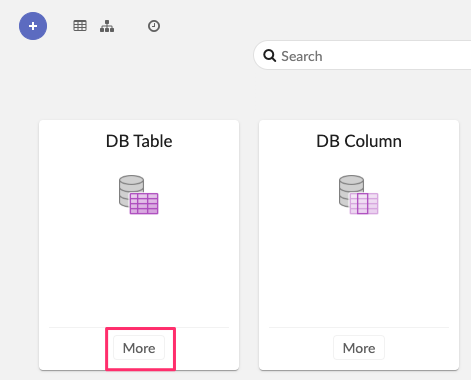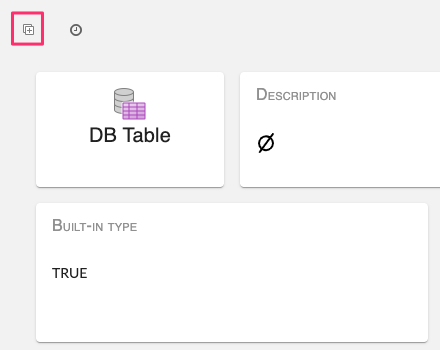Manage asset types
TIBCO Cloud™ Metadata already includes default asset types. You can create a new asset type if needed.
Default asset types
List of default asset types included in TIBCO Cloud™ Metadata.
| Name | Description | Asset type's parent | Specific included fields |
|---|---|---|---|
| DB table | Collection of related data held in a table format within a database. It consists of columns and rows. | DB Schema |
- Encoding - Partitioned DB table - TableSpace - Encryption - Sample file |
| DB Column | Set of data values of particular simple type. May contain text values, numbers or even pointers to files in the operating system. | DB Table |
- Field type - Precision - Encryption - Column index - Sample file |
| DB Schema | Database structure described in a formal language supported by the database management system. | - Tablespace | |
| DB View | Searchable object in a database that is defined by a query. | DB Schema | - Tablespace |
| DB Function | Perfom basic operations, such as Sum, Average, Count, etc., and additionnally use criteria arguments, that allow you to perform the calculation only for a specified subset of the records in your database. | DB Schema | - Tablespace |
| DB Synonym | Represent an alias or alternate name for table, view, sequence or other schema object. | DB Schema | - Tablespace |
| DB Sequence | Database object which allows users to generate unique integer values. | DB Schema | - Tablespace |
| REST Service | REST web services allow querying systems to manipulate web resources via their textual representations through a set of uniform, stateless, predefined operations. |
- Version - URL (endpoint or URI) |
|
| REST Resource | Object with a type, associated data, relationships to other resources, and a set of methods that operate on it. | REST Service |
- Field type - URL (endpoint or URI) |
| SOAP Service | Simple object access protocol service for exchanging structured information. |
- Version - URL (endpoint or URI) |
|
| SOAP Operation | Operation in a SOAP service like getRecord, count, Create, etc. | SOAP Service |
- URL (endpoint or URI) |
| SOAP Request | Request to access soap operation. | SOAP Operation | |
| SOAP Response | Response returned from a soap request link to a specific soap operation. | SOAP Operation | |
| Excel Workbook | Collection of one or more spreadsheets also called worksheets. |
- Version - Encoding - Locale - Attribute value - Encryption - File name - File size - File extension - Header present - Protected - Sample file |
|
| Excel Worksheet | Single page in a file created with Excel. | Excel Workbook |
- Protected - Order - Sample file |
| Excel Worksheet Array | Array of worksheet. | Excel worksheet |
- Number of lines - Start line - Protected - Sample file |
| CSV file | Comma separated value file which allows data to be saved in a tabular format. |
- Version - Encoding - Encryption - File name - File size - File extension - Line separator - String delimiter - Header present - Start line - Protected - Sample file |
|
| Column | Represent a column in a CSV file or excel worksheet. | - CSV file - Excel Worksheet |
- Format - Field type - Default value - String delimiter - Column index - Row index - Formula - Orientation - Sample file |
| XML File | Extensible markup language data file. Formatted much like and HTML document but uses customs tags to define object and the data within each object. |
- Version - Encoding - XML Encoding - Encryption - File name - File size - File extension - Protected - Sample file |
|
| XML Stream | Stream of xml content. |
- Encoding - XML Encoding |
|
| XML Element | Is everything from the element's start tag to the element's end tag. | - XML file - XML Stream |
- Field type - Node type - Default value - TagName (attribute name) - Pattern - Range - Enumeration - Maximum length - Minimum length - Sample file |
| XML Attribute | Contains data related to a specific element. | XML Element |
- Field type - Default value - Sample file |
| JSON File | File that stores simple data structures and objects in JavaScript Object Notation(JSON) format, which is a standard data exchange format. |
- Version - Encoding - Encryption - File name - File size - File extension - Protected - Sample file |
|
| JSON Element | Data structure in a JSON. Data can be a json object, text, number, boolean, etc. |
- JSON file - JSON stream |
- Format - Field type - Default value - Array length - Media encoding - Content media type - Pattern - Range - Enumeration - Maximum length - Minimum length - Sample file |
| JSON Property | Each JSON Element is identified by its JSON property. | JSON Element |
- Field type - Default value - Sample file |
| JSON Stream | Stream of JSON content. |
- Encoding |
|
| TDV Published view | Specific TIBCO® Data Virtualization published view. |
- Encoding - Sample file |
|
| Undefined | Default asset type for unknown format. |
As you can see, an asset type can have multiple specifics fields. This is necessary for the asset form to display specific attributes related to the asset type you have selected.
For example, if you create a new asset using asset type “DB Column”, you will see additional attributes in the asset’s form view. These attributes are :
- Field type
- Precision
- Encryption
- Column index
- Sample file
Create a new asset type
You can create a new asset type by clicking the “+” button on the top left corner of the asset type main view.
You will see a form with fields to complete.
| Field | Description |
|---|---|
| Identifier |
This field is mandatory Asset type's unique identifier. Auto incremented. |
| Label |
This field is mandatory Asset type's label. |
| Description | Describe your new asset type here. |
| Logo |
This field is mandatory Use a built-in logo or custom logo. By using a custom logo, you can also upload a new logo if needed. Size limit is 64x64 pixels. |
| Logo (for hierarchy display) |
This field is mandatory Same as 'Logo' but needed for the hierarchy view. Size limit is 16x16 pixels. |
| Built-in type | Is default asset from TIBCO Cloud™ Metadata. False by default and not editable. |
| Parents | Define asset type's parents here. |
| Can be composed by itself | True if possible, if not false. |
| Asset attributes | Select specific asset attributes you want to add. Each specific attribute can be mandatory. |
| Documentation | Insert new asset type's documentation here (Office documents, images, etc). |
| Children | Not editable. If the new asset type is a Parent, you see child asset types here. |
| Assets | Not editable. Assets which use the current asset type. |
Duplicate asset type
If you want to create your own asset type from an existing default one, you can click on the duplicate action button.
First of all, you will need to display the asset type you want to duplicate by clicking on it if you are in the hierarchical view or clicking on the “more” button in the card view mode.

In the asset type view form, click on the “duplicate” button on the top left corner.

You will see a pre-filled form in which you can make your updates.
